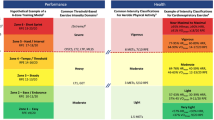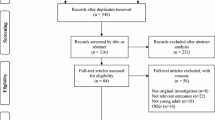Abstract
The present study evaluated the effect of 35 days of experimental horizontal bed-rest on exercise and immersion thermoregulatory function. Fifteen healthy male volunteers were assigned to either a Control (n=5) or Bed-rest (n=10) group. Thermoregulatory function was evaluated during a 30-min bout of submaximal exercise on a cycle ergometer, followed immediately by a 100-min immersion in 28°C water. For the Bed-rest group, exercise and immersion thermoregulatory responses observed post-bed-rest were compared with those after a 5 week supervised active recovery period. In both trials, the absolute work load during the exercise portion of the test was identical. During the exercise and immersion, we recorded skin temperature, rectal temperature, the difference in temperature between the forearm and third digit of the right hand (ΔTforearm-fingertip)— an index of skin blood flow, sweating rate from the forehead, oxygen uptake and heart rate at minute intervals. Subjects provided ratings of temperature perception and thermal comfort at 5-min intervals. Exercise thermoregulatory responses after bed-rest and recovery were similar. Subjective ratings of temperature perception and thermal comfort during immersion indicated that subjects perceived similar combinations of Tsk and Tre to be warmer and thermally less uncomfortable after bed-rest. The average (SD) exercise-induced increase in Tre relative to resting values was not significantly different between the Post-bed-rest (0.4 (0.2)°C) and Recovery (0.5 (0.2)°C) trials. During the post-exercise immersion, the decrease in Tre, relative to resting values, was significantly (P<0.05) greater in the Post-bed-rest trial (0.9 (0.5)°C) than after recovery (0.4 (0.3)°C). ΔTforearm-fingertip was 5.2 (0.9)°C and 5.8 (1.0)°C at the end of the post-bed-rest and recovery immersions, respectively. The gain of the shivering response (increase in V̇O2 relative to the decrease in Tre; V̇O2/Tre) was 1.19 l min−1°C−1 in the Recovery trial, and was significantly attenuated to 0.51 l min−1°C−1 in the Post-bed-rest trial. The greater cooling rate observed in the post-bed-rest trial is attributed to the greater heat loss and reduced heat production. The former is the result of attenuated cold-induced vasoconstriction and enhanced sweating rate, and the latter a result of a lower shivering V̇O2 response.



Similar content being viewed by others
References
Baker MA (1984) Influence of dehydration on thermoregulation in panting mammals. In: Hales JR (ed) Thermal Physiology. Raven Press, New York, pp 407–412
Baker MA, Doris PA (1982a) Effect of dehydration on hypothalamic control of evaporation in the cat. J Physiol (Lond) 322:457–468
Baker MA, Doris PA (1982b) Control of evaporative heat loss during changes in plasma osmolality. J Physiol (Lond) 328:535–545
Berg HE, Dudley GA, Haggmark T, Ohlsen H, Tesch PA (1991) Effects of lower limb unloading on skeletal muscle mass and function in humans. J Appl Physiol 70:1882–1885
Berg HE, Larsson L, Tesch PA (1997) Lower limb skeletal muscle function after 6 wk of bed-rest. J Appl Physiol 82:182–188
Candas V, Libert JP, Brandenberger G, Sagot JC, Amoros C, Kahn JM (1986) Hydration during exercise: Effects on thermal and cardiovascular function. Eur J Appl Physiol 55:113–122
Convertino V (1996) Exercise and adaptation to microgravity environments. In: Fregly MJ, Blatteis CM (eds) Handbook of Physiology, Sect. IV. environmental physiology. Oxford University Press, Oxford, pp 815–843
Crandall CG, Johnson JM, Convertino VA, Raven PB, Engelke KA(1994) Altered thermoregulatory responses after 15 days of head-down tilt. J Appl Physiol 77:1863–1867
Durnin JVGA, Womersley J (1974) Body fat assessed from total body density and its estimation from skinfold thickness:measurements on 481 men aged 16 to 72 years. Br J Nutr 32:77–97
Edgerton VR, Roy RR (1996) Neuromuscular adaptations to actual and simulated spaceflight. In: Fregly MJ, Blatteis CM (eds) Handbook of Physiology, Section IV, Environmental Physiology. Oxford University Press, Oxford, pp 721–763
Eiken O, Kolegard R (2001) Vascular responses to elevated intravascular pressure: adaptive changes in man due to repeated exposures. J Physiol (Lond) 531:51P
Eiken O, Mekjavic IB (2004) Ischaemia in working muscles potentiates the exercise-induced sweating response in man. Acta Physiol Scand 181:305–311
Eiken O, Kolegard R, Lindborg B and Mekjavic IB (2002) Pressure distension in arteries and arterioles. In: Eiken O, Mekjavic IB (eds) The Valdoltra bed-rest study: effects of 35 days of horizontal bed-rest on the function of peripheral blood vessels, the thermoregulatory system and on the function and structure of the musculoskeletal system. FOI Report No 0748-SE. NBC Defence, Defence Medicine: Umea, Sweden
Ekblom B, Greenleaf CJ, Greenleaf JE, Hermansen L (1970) Temperature regulation during exercise dehydration in man. Acta Physiol Scand 79:475–483
Ferretti G, Berg HE, Minetti AE, Moia C, Rampichini S, Narici MV(2001). Maximal instantaneous muscular power after prolonged bed-rest in humans. J Appl Physiol 90:431–435
Fortney SM (1987) Thermoregulatory adaptations to inactivity. In: Samueloff S, Yousef MK (eds) Adaptive Physiology to Stressful Environments. CRC Press, Boca Raton, pp 75–83
Fortney SM, Vroman NB (1985) Exercise, peformance and temperature control: temperature regulation during exercise and implications for sports performance and training. Sports Med 2:8–20
Fortney SM, Nadel ER, Wenger CB, Bove JR(1981) Effect of body volume on sweating rate and body fluids in exercising humans. J Appl Physiol 51:1594–1600
Fortney SM, Hyatt KH, Davis JE, Vogel JM (1991) Changes in body fluid compartments during a 28-day bed-rest. Aviat Space Environ Med 62: 97–104
Fortney SM, Schneider VS, Greenleaf JE (1996) The physiology of bed-rest. In: Fregly MJ, Blatteis CM (eds) Handbook of physiology, Sect. IV. Environmental physiology. Oxford University Press, Oxford, pp 889–939
Fortney SM, Mikhaylov V, Lee SMC, Kobzev Y, Gonzalez RR, Greenleaf JE (1998) Body temperature and thermoregulation during submaximal exercise after 115-day spaceflight. Aviat Space Environ Med 69:137–141
Gleeson M (1998) Temperature regulation during exercise. Int J Sports Med 19(Suppl 2):S96–S99
Golja P, Eiken O, Rodman S, Sirok B, Mekjavic IB (2002) Core temperature circadian rhythm during 35 days horizontal bed-rest. J Gravit Physiol 9:187–188
Greenleaf JE (1989) Energy and thermal regulation during bed-rest and spaceflight. J Appl Physiol 67:507–516
Greenleaf JE, Reese JD (1980) Exercise thermoregulation after 14 days of bed-rest. J Appl Physiol 48:72–78
Grucza R, Lecroart JL, Carette G, Hauser JJ, Houdas Y (1987) Effect of voluntary dehydration on thermoregulatory responses to heat in men and women. Eur J Appl Physiol 56:317–322
Kozlovskaya IB, Kreidich YV, Oganov VS, Koserenko OP (1981) Pathophysiology of motor functions in prolonged space flights. Acta Astronaut 8:1059–1072
Lee SMC, Williams WJ, Schneider SM (2002) Role of skin blood flow and sweating rate in exercise thermoregulation after bed-rest. J Appl Physiol 92:2026–2034
Mekjavic IB, Sundberg CJ, Linnarsson D (1991) Core temperature “null zone”. J Appl Physiol 71:1289–1295
Rubinstein EH, Sessler D (1990) Skin-surface temperature gradients correlate with fingertip blood flow in humans. Anesthesiol 73:541–545
Silva LN, Boulant AJ (1984) Effects of osmotic pressure, glucose, and temperature on neurons in preoptic tissue slices. Amer J Physiol 247: R335–R345
Sulzman FM, Ferraro JS, Fuller CA, Moore-Ede MC, Klimovitsky V, Magedov V, Alpatov AM (1992) Thermoregulatory responses of Rhesus monkeys during spaceflight. Physiol Behav 51:585–591
Taylor NA (1986) Eccrine sweat glands Adaptations to physical training and heat acclimation. Sports Med 3:387–397
Taylor HL, Henschel A, Brozek J, Keys A (1949) Effects of bed-rest on cardiovascular function and work performance. J Appl Physiol 2: 223–229
Williams BA, Reese RD (1976) Effect of bedrest on thermoregulation. In: Greenleaf JE, Greenleaf CJ, Van Derveer D, Dorchak KJ (ed) Adaptations to prolonged bedrest in man: a compendium of research. NASA, Washington DC (NASA Technical Memorandum X-3307), pp 140–141
Winget CM, Vernikos-Daniellis J, Cronin, SE, Leach CS, Rambaut PC, Mack PB (1972) Circadian rhythm asynchrony in man during hypokinesis. J Appl Physiol 33:640–643
Acknowledgements
The authors are indebted to the subjects, particularly those in the Bed-rest group, for their efforts and dedication to the study. The assistance and support of the staff at the Valdoltra Orthopaedic Hospital, particularly that of Prim. dr. Vencesalv Pisot and Mrs. Stanislava Skrabec, is also gratefully acknowledged. This study was supported, in part, by the Swedish Defence Research Agency, the Slovenian Ministry of Education, Science and Sport, Orthopaedic Hospital Valdoltra and Jozef Stefan Institute.
Author information
Authors and Affiliations
Corresponding author
Rights and permissions
About this article
Cite this article
Mekjavic, I.B., Golja, P., Tipton, M.J. et al. Human thermoregulatory function during exercise and immersion after 35 days of horizontal bed-rest and recovery. Eur J Appl Physiol 95, 163–171 (2005). https://doi.org/10.1007/s00421-005-1348-x
Received:
Accepted:
Published:
Issue Date:
DOI: https://doi.org/10.1007/s00421-005-1348-x




